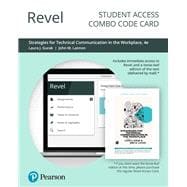For introductory courses in Technical Communication
Practical strategies for writing in the modern workplace
Drawn from the strengths of their acclaimed Technical Communication, Gurak and Lannon’s Revel™ Strategies for Technical Communication in the Workplace helps professionals in all fields adapt their communication strategies as they navigate the global marketplace. This innovative book offers a clear and concise writing style, practical applications, numerous sample documents, coverage of technology and global issues, and many useful checklists to prepare for any situation.
The 4th Edition maintains its focus on audience and purpose, while offering many new features – particularly updated discussions and examples of digital communication technologies. And with a fresh new look and brief format, it’s sure to appeal to learners of all writing levels.
Revel is Pearson’s newest way of delivering our respected content. Fully digital and highly engaging, Revel replaces the textbook and gives students everything they need for the course. Informed by extensive research on how people read, think, and learn, Revel is an interactive learning environment that enables students to read, practice, and study in one continuous experience — for less than the cost of a traditional textbook.
NOTE: This Revel Combo Access pack includes a Revel access code plus a loose-leaf print reference (delivered by mail) to complement your Revel experience. In addition to this access code, you will need a course invite link, provided by your instructor, to register for and use Revel.












